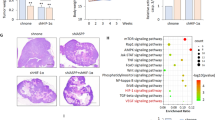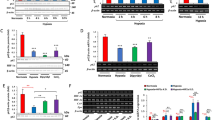Abstract
Inactivation of von Hippel–Lindau tumor-suppressor protein (pVHL) is associated with von Hippel–Lindau disease, an inherited cancer syndrome, as well as the majority of patients with sporadic clear cell renal cell carcinoma (RCC). Although the involvement of pVHL in oxygen sensing through targeting hypoxia-inducible factor-α subunits to ubiquitin-dependent proteolysis has been well documented, less is known about pVHL regulation under both normoxic and hypoxic conditions. We found that pVHL levels decreased in hypoxia and that hypoxia-induced cell cycle arrest is associated with pVHL expression in RCC cells. pVHL levels fluctuate during the cell cycle, paralleling cyclin B1 levels, with decreased levels in mitosis and G1. pVHL contains consensus destruction (D) box sequences, and pVHL associates with Cdh1, an activator of the anaphase-promoting complex/cyclosome (APC/C) E3 ubiquitin ligase. We show that pVHL has a decreased half-life in G1, Cdh1 downregulation results in increased pVHL expression, whereas Cdh1 overexpression results in decreased pVHL expression. Taken together, these results suggest that pVHL is a novel substrate of APC/CCdh1. D box-independent pVHL degradation was also detected, indicating that other ubiquitin ligases are also activated for pVHL degradation.
This is a preview of subscription content, access via your institution
Access options
Subscribe to this journal
Receive 50 print issues and online access
$259.00 per year
only $5.18 per issue
Buy this article
- Purchase on Springer Link
- Instant access to full article PDF
Prices may be subject to local taxes which are calculated during checkout








Similar content being viewed by others
References
Baker DJ, Dawlaty MM, Galardy P, van Deursen JM . (2007). Mitotic regulation of the anaphase-promoting complex. Cell Mol Life Sci 64: 589–600.
Beroud C, Collod-Beroud G, Boileau C, Soussi T, Junien C . (2000). UMD (universal mutation database): a generic software to build and analyze locus-specific databases. Hum Mutat 15: 86–94.
Chi JT, Wang Z, Nuyten DS, Rodriguez EH, Schaner ME, Salim A et al. (2006). Gene expression programs in response to hypoxia: cell type specificity and prognostic significance in human cancers. PLoS Med 3: e47.
de Paulsen N, Brychzy A, Fournier MC, Klausner RD, Gnarra JR, Pause A et al. (2001). Role of transforming growth factor-alpha in von Hippel--Lindau (VHL)(-/-) clear cell renal carcinoma cell proliferation: a possible mechanism coupling VHL tumor suppressor inactivation and tumorigenesis. Proc Natl Acad Sci USA 98: 1387–1392.
Deshaies RJ, Joazeiro CA . (2009). RING domain E3 ubiquitin ligases. Annu Rev Biochem 78: 399–434.
Fähling M . (2009). Cellular oxygen sensing, signalling and how to survive translational arrest in hypoxia. Acta Physiologica 195: 205–230.
Gardner LB, Li Q, Park MS, Flanagan WM, Semenza GL, Dang CV . (2001). Hypoxia inhibits G1/S transition through regulation of p27 expression. J Biol Chem 276: 7919–7926.
Gordan JD, Bertout JA, Hu CJ, Diehl JA, Simon MC . (2007). HIF-2alpha promotes hypoxic cell proliferation by enhancing c-myc transcriptional activity. Cancer Cell 11: 335–347.
Hackenbeck T, Knaup KX, Schietke R, Schödel J, Willam C, Wu X et al. (2009). HIF-1 or HIF-2 induction is sufficient to achieve cell cycle arrest in NIH3T3 mouse fibroblasts independent from hypoxia. Cell Cycle 8: 1386–1395.
Harper JV . (2005). Synchronization of cell populations in G1/S and G2/M phases of the cell cycle. Methods Mol Biol 296: 157–166.
Hergovich A, Lisztwan J, Barry R, Ballschmieter P, Krek W . (2003). Regulation of microtubule stability by the von Hippel-Lindau tumour suppressor protein pVHL. Nat Cell Biol 5: 64–70.
Iliopoulos O, Kibel A, Gray S, Kaelin WG . (1995). Tumor suppression by the human von Hippel-Lindau gene product. Nat Med 1: 822–826.
Iliopoulos O, Ohh M, Kaelin Jr WG . (1998). pVHL19 is a biologically active product of the von Hippel-Lindau gene arising from internal translation initiation. Proc Natl Acad Sci USA 95: 11661–11666.
Jackson PK . (2004). Linking tumor suppression, DNA damage and the anaphase-promoting complex. Trends Cell Biol 14: 331–334.
Jung CR, Hwang KS, Yoo J, Cho WK, Kim JM, Kim WH et al. (2006). E2-EPF UCP targets pVHL for degradation and associates with tumor growth and metastasis. Nat Med 12: 809–816.
Kaelin WG . (2005). Proline hydroxylation and gene expression. Annu Rev Biochem 74: 115–128.
Kaelin WG . (2007a). Von Hippel-Lindau disease. Annu Rev Pathol 2: 145–173.
Kaelin Jr WG . (2007b). The von Hippel-Lindau tumor suppressor protein and clear cell renal carcinoma. Clin Cancer Res 13: 680s–684s.
Kaelin Jr WG . (2008). The von Hippel-Lindau tumour suppressor protein: O2 sensing and cancer. Nat Rev Cancer 8: 865–873.
Koshiji M, Kageyama Y, Pete EA, Horikawa I, Barrett JC, Huang LE . (2004). HIF-1alpha induces cell cycle arrest by functionally counteracting Myc. EMBO J 23: 1949–1956.
Lendahl U, Lee KL, Yang H, Poellinger L . (2009). Generating specificity and diversity in the transcriptional response to hypoxia. Nat Rev Genet 10: 821–832.
Listovsky T, Oren YS, Yudkovsky Y, Mahbubani HM, Weiss AM, Lebendiker M et al. (2004). Mammalian Cdh1/Fzr mediates its own degradation. EMBO J 23: 1619–1626.
Liu L, Simon MC . (2004). Regulation of transcription and translation by hypoxia. Cancer Biol Ther 3: 492–497.
Liu W, Li W, Fujita T, Yang Q, Wan Y . (2008). Proteolysis of CDH1 enhances susceptibility to UV radiation-induced apoptosis. Carcinogenesis 29: 263–272.
Liu W, Wu G, Li W, Lobur D, Wan Y . (2007). Cdh1-anaphase-promoting complex targets Skp2 for destruction in transforming growth factor beta-induced growth inhibition. Mol Cell Biol 27: 2967–2979.
Musacchio A, Salmon ED . (2007). The spindle-assembly checkpoint in space and time. Nat Rev Mol Cell Biol 8: 379–393.
Pause A, Lee S, Lonergan KM, Klausner RD . (1998). The von Hippel-Lindau tumor suppressor gene is required for cell cycle exit upon serum withdrawal. Proc Natl Acad Sci USA 95: 993–998.
Pfleger CM, Lee E, Kirschner MW . (2001). Substrate recognition by the Cdc20 and Cdh1 components of the anaphase-promoting complex. Genes Dev 15: 2396–2407.
Schmaltz C, Hardenbergh PH, Wells A, Fisher DE . (1998). Regulation of proliferation-survival decisions during tumor cell hypoxia. Mol Cell Biol 18: 2845–2854.
Schoenfeld A, Davidowitz EJ, Burk RD . (1998). A second major native von Hippel-Lindau gene product, initiated from an internal translation start site, functions as a tumor suppressor. Proc Natl Acad Sci USA 95: 8817–8822.
Semenza GL . (2009). Involvement of oxygen-sensing pathways in physiologic and pathologic erythropoiesis. Blood 114: 2015–2019.
Stebbins CE, Kaelin Jr WG, Pavletich NP . (1999). Structure of the VHL-ElonginC-ElonginB complex: implications for VHL tumor suppressor function. Science 284: 455–461.
Stickle NH, Cheng LS, Watson IR, Alon N, Malkin D, Irwin MS et al. (2005). Expression of p53 in renal carcinoma cells is independent of pVHL. Mut Res 578: 23–32.
Sudo T, Ota Y, Kotani S, Nakao M, Takami Y, Takeda S et al. (2001). Activation of Cdh1-dependent APC is required for G1 cell cycle arrest and DNA damage-induced G2 checkpoint in vertebrate cells. EMBO J 20: 6499–6508.
Thoma CR, Frew IJ, Hoerner CR, Montani M, Moch H, Krek W . (2007). pVHL and GSK3beta are components of a primary cilium-maintenance signalling network. Nat Cell Biol 9: 588–595.
Thoma CR, Toso A, Gutbrodt KL, Reggi SP, Frew IJ, Schraml P et al. (2009). VHL loss causes spindle misorientation and chromosome instability. Nat Cell Biol 11: 994–1001.
van Leuken R, Clijsters L, Wolthuis R . (2008). To cell cycle, swing the APC/C. Biochimica et Biophysica Acta 1786: 49–59.
Wan Y, Liu X, Kirschner MW . (2001). The anaphase-promoting complex mediates TGF-beta signaling by targeting SnoN for destruction. Mol Cell 8: 1027–1039.
Warnecke C, Weidemann A, Volke M, Schietke R, Wu X, Knaup KX et al. (2008). The specific contribution of hypoxia-inducible factor-2alpha to hypoxic gene expression in vitro is limited and modulated by cell type-specific and exogenous factors. Exp Cell Res 314: 2016–2027.
Wasch R, Robbins JA, Cross FR . (2010). The emerging role of APC/C(Cdh1) in controlling differentiation, genomic stability and tumor suppression. Oncogene 29: 1–10.
Wei W, Ayad NG, Wan Y, Zhang GJ, Kirschner MW, Kaelin Jr WG . (2004). Degradation of the SCF component Skp2 in cell-cycle phase G1 by the anaphase-promoting complex. Nature 428: 194–198.
Wykoff CC, Sotiriou C, Cockman ME, Ratcliffe PJ, Maxwell P, Liu E et al. (2004). Gene array of VHL mutation and hypoxia shows novel hypoxia-induced genes and that cyclin D1 is a VHL target gene. Br J Cancer 90: 1235–1243.
Young AP, Schlisio S, Minamishima YA, Zhang Q, Li L, Grisanzio C et al. (2008). VHL loss actuates a HIF-independent senescence programme mediated by Rb and p400. Nat Cell Biol 10: 361–369.
Acknowledgements
We thank Dr Arthur Haas, for support and discussions, Eric Hittle, Kimberlee Rankin, Mike Meyer, and Miki Katuwal for technical assistance, and the Cancer Association of Greater New Orleans for support to HX. This work was supported by the LSUHSC-NO Dean's Research Fund and NIH grant CA125930. DTE was supported by T32DK007774.
Author information
Authors and Affiliations
Corresponding author
Ethics declarations
Competing interests
The authors declare no conflict of interest.
Additional information
Supplementary Information accompanies the paper on the Oncogene website
Rights and permissions
About this article
Cite this article
Liu, W., Xin, H., Eckert, D. et al. Hypoxia and cell cycle regulation of the von Hippel–Lindau tumor suppressor. Oncogene 30, 21–31 (2011). https://doi.org/10.1038/onc.2010.395
Received:
Revised:
Accepted:
Published:
Issue Date:
DOI: https://doi.org/10.1038/onc.2010.395
Keywords
This article is cited by
-
Role of the human solute carrier family 14 member 1 gene in hypoxia-induced renal cell carcinoma occurrence and its enlightenment to cancer nursing
BMC Molecular and Cell Biology (2023)
-
Novel interactions of the von Hippel-Lindau (pVHL) tumor suppressor with the CDKN1 family of cell cycle inhibitors
Scientific Reports (2017)
-
RHOBTB3 promotes proteasomal degradation of HIFα through facilitating hydroxylation and suppresses the Warburg effect
Cell Research (2015)
-
The double life of MULE in preeclamptic and IUGR placentae
Cell Death & Disease (2012)
-
The LIMD1 protein bridges an association between the prolyl hydroxylases and VHL to repress HIF-1 activity
Nature Cell Biology (2012)



